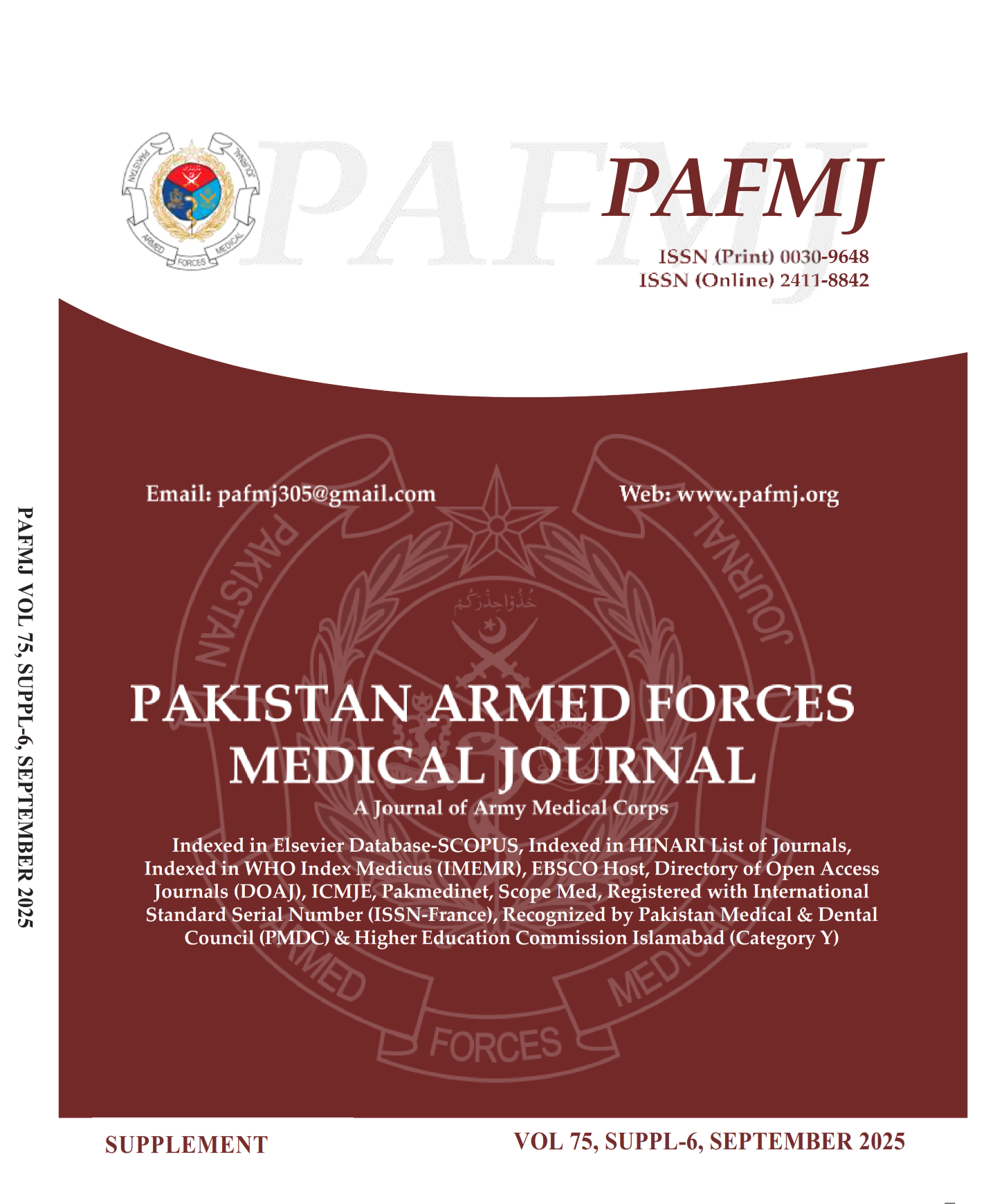Diagnostic Accuracy of Grey Ultrasound in Antenatal Diagnosis of Morbidly Adherent Placenta, Taking Per-Operative Findings of Caesarean Section as Gold Standard
DOI:
https://doi.org/10.51253/pafmj.v75iSUPPL-6.5995Keywords:
Diagnosis, Doppler Ultrasound, Morbidly Adherent Placenta.Abstract
Objective: To assess the diagnostic accurateness of grey ultrasound in the antenatal diagnosis of morbidly adherent placenta, taking per- operative findings of caesarean section as gold standard.
Study Design: Cross sectional study.
Place and Duration of Study: Radiology Department in collaboration with Obstetrics and Gynecology Department, Pak Emirates Military Hospital, Rawalpindi Pakistan, from Aug 2019 to Aug 2020.
Methodology: 89 pregnant women registered with diagnosis of placenta Previa in present pregnancy were included. Primi-gravida and females with pregnancies complicated by diabetes, heart disease and hypertension were omitted from study. All patients endured grey ultrasound examination and revealed absence or presence of morbidly adherent placenta Previa. Grey ultrasound results were associated with surgical per-operative findings.
Results: The mean age of the patients was 27.78±2.65 years. In patients with positive ultrasound results, 01 was false positive and 10 were true positive. Of the 78 ultrasound negative results, true negative were 70 patients and 02 were false negative (p=1000). Of the 78 ultrasound negative results, true negative were 70 patients and 02 were false negative (p=1000). Specificity, sensitivity, negative predictive value, positive predictive value and diagnostic accurateness of grey ultrasound in the antenatal analysis of morbidly adherent placenta are 98.36%, 87.5%, 98.36%, 87.5% and 97.10%, respectively.
Conclusion: In this study, the grey ultrasonography showed greater diagnostic accuracy in the prenatal detection of the morbidly adherent placenta in pregnant women with placenta previa.
Downloads
References
1. Sattar A, Bashir H, Rana S, Anjum S. Diagnostic Value of Magnetic Resonance Imaging (MRI) in Morbidly Adherent Placenta, Taking Surgical Findings as Gold Standard. Med Forum 2020; 31(8): 8-11.
2. Asghar S, Naz N. Diagnostic Accuracy of Doppler Ultrasound for Antenatal Detection of Placenta Accreta Spectrum (PAS) Disorders. J Gynecol Obstetric 2020; 8(1): 12-15.
3. Faraji A, Akbarzadeh-Jahromi M, Bahrami S, Gharamani S, Raeisi Shahraki H, et al. Predictive value of vascular endothelial growth factor and placenta growth factor for placenta accreta spectrum. J Obstet Gynaecol 2021: 1-6.
https://doi.org/10.1080/01443615.2021.1955337
4. Rathbun KM, Hildebrand JP. Placenta Abnormalities. 2021. StatPearls Publishing; 2022 Jan. PMID: 29083591.
5. Lopes ES, Feitosa FEL, Brazil AV, de Castro JDV, da Costa JIF, Araujo Júnior et al. Assessment of Sensitivity and Specificity of Ultrasound and Magnetic Resonance Imaging in the Diagnosis of Placenta Accreta. Rev Bras Ginecol Obstet 2019; 41(1): 17-23.
https://doi.org/10.1055/s-0038-1675803
6. Boroomand Fard M, Kasraeian M, Vafaei H, Jahromi MA, Arasteh P, Shahraki HR, et al. Introducing an efficient model for the prediction of placenta accreta spectrum using the MCP regression approach based on sonography indexes: how efficient is sonography in diagnosing accreta? BMC Pregnancy Childbirth 2020; 20(1): 111.
https://doi.org/10.1186/s12884-020-2799-0
7. Takeda S, Takeda J, Makino S. Cesarean Section for Placenta Previa and Placenta Previa Accreta Spectrum. Surg J (N Y) 2020; 6(Suppl 2): S110-S121. https://doi.org/10.1055/s-0039-3402036
8. Welz J, Keyver-Paik MD, Gembruch U, Merz WM. Self-reported physical, mental, and reproductive sequelae after treatment of abnormally invasive placenta: a single-center observational study. Arch Gynecol Obstet 2019; 300(1): 95-101.
https://doi.org/10.1007/s00404-019-05175-z
9. Gao Y, Gao X, Cai J, Han F, Xu G, Zhang X, et al. Prediction of placenta accreta spectrum by a scoring system based on maternal characteristics combined with ultrasonographic features. Taiwan J Obstet Gynecol 2021; 60(6): 1011-1017.
https://doi.org/10.1016/j.tjog.2021.09.011
10. El-Ewiny I, Kassab F, Abdul-Jaleel K. The Role of Ultrasound versus Hysteroscopy in Assessment of Cesarean Section Scar in Non Pregnant Females. Egypt J Hosp Med 2019; 74(4): 775-781.
https://doi.org/10.21608/ejhm.2019.24171
11. Chaudhari HK, Shah PK, D'Souza N. Morbidly Adherent Placenta: Its Management and Maternal and Perinatal Outcome. J Obstet Gynaecol India 2017; 67(1): 42-47.
https://doi.org/10.1007/s13224-016-0923-x
12. Niushko TY, Tarasiuk OK, Sikalo YK. The effectiveness of combinated antihypertensive treatment in patients with essential hypertension of the ii-nd stage depending on the type of daily blood pressure profile and the type of remodelling of the left ventricle. Wiad Lek 2020; 73(1): 46-51.
13. Kadkhoda Z, Tavakoli A, Chokami Rafiei S, Zolfaghari F, Akbari S. Effect of Amniotic Membrane Dressing on Pain and Healing of Palatal Donor Site: A Randomized Controlled Trial. Int J Organ Transplant Med 2020; 11(2): 55-62.
14. Khalid D, Noreen A, Javed AM, Zahra M, Gul M, Shakir A. Diagnostic Accuracy of Color Doppler Ultrasound in Antenatal Diagnosis of Morbidly Adherent Placenta, taking Operative Findings of Caesarean Section as Gold Standard. Pak J Med Health Sci 2016; 10(2): 478-481.
15. Calì G, Giambanco L, Puccio G, Forlani F. Morbidly adherent placenta: evaluation of ultrasound diagnostic criteria and differentiation of placenta accreta from percreta. Ultrasound Obstet Gynecol 2013; 41(4): 406-412.
https://doi.org/10.1002/uog.12385
16. Naz N, Memon S, Majeed AI. Diagnostic Role of Doppler Ultrasound in Morbidly Adherent Placenta (MAP): An Obstetrical Emergency. J. Soc. Obstet. Gynaecol. Pak 2016; 6(4): 165-170.
17. Baughman WC, Corteville JE, Shah RR. Placenta accreta: spectrum of US and MR imaging findings. Radiographics. 2008; 28(7): 1905-16. https://doi.org/10.1148/rg.287085060
18. Gulati A, Anand R, Aggarwal K, Agarwal S, Tomer S. Ultrasound as a Sole Modality for Prenatal Diagnosis of Placenta Accreta Spectrum: Potentialities and Pitfalls. Indian J Radiol Imaging 2021; 31(3): 527-538.
https://doi.org/10.1055/s-0041-1735864
19. Riteau AS, Tassin M, Chambon G, et al. Accuracy of ultrasonography and magnetic resonance imaging in the diagnosis of placenta accreta. PLoS One 2014; 9(4): e94866.
https://doi.org/10.1371/journal.pone.0094866
20. Abinader R, Warsof SL. Benefits and Pitfalls of Ultrasound in Obstetrics and Gynecology. Obstet Gynecol Clin North Am 2019; 46(2): 367-378.
Downloads
Published
Issue
Section
License
Copyright (c) 2025 Durr-e- Shahwar, Abeera Choudhry, Khalida ., Insha Tahir, Zareen Tahir, Sundus Arif

This work is licensed under a Creative Commons Attribution-NonCommercial 4.0 International License.















